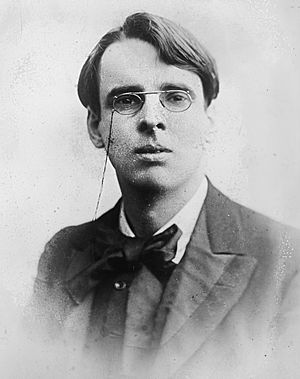The Lake Isle of Innisfree facts for kids
I will arise and go now, and go to Innisfree,
And a small cabin build there, of clay and wattles made;
Nine bean rows will I have there, a hive for the honey bee,
And live alone in the bee-loud glade.
And I shall have some peace there, for peace comes dropping slow,
Dropping from the veils of the morning to where the cricket sings;
There midnight's all a glimmer, and noon a purple glow,
And evening full of the linnet's wings.
I will arise and go now, for always night and day
I hear lake water lapping with low sounds by the shore;
While I stand on the roadway, or on the pavements grey,
I hear it in the deep heart's core.
The Lake Isle of Innisfree is a famous poem by William Butler Yeats. He wrote it in 1888, and it was first printed in 1890. The poem has twelve lines, divided into three groups of four lines, called quatrains. It's a beautiful poem about wanting to escape city life and find peace in nature.
This poem is a great example of the Celtic Revival. This was a movement where Irish artists wanted to create their own unique style. They wanted their art to feel truly Irish, not just like English art. The poem became very popular in the United Kingdom and France. You can even find parts of it in Irish passports!
Background of the Poem
Innisfree is a small, empty island in Lough Gill, Ireland. Yeats spent his summers there when he was a child. The idea for the poem came to him suddenly in 1888. He was walking in London, far from home, and felt a bit homesick.
He saw a fountain in a shop window. The water in the fountain reminded him of the lake water back in Ireland. This memory made him think of his childhood dream. He had always wanted to live simply on Innisfree, like the writer Henry David Thoreau. This strong feeling of remembering the lake inspired him to write "The Lake Isle of Innisfree." It was one of his first poems that truly sounded like his own unique style.
Music Inspired by the Poem
Many musicians have been inspired by "The Lake Isle of Innisfree." They have turned the poem into songs or mentioned it in their music.
- Muriel Herbert created a song from the poem in 1928.
- The Irish group Anúna arranged it as a choral piece.
- Composer and pianist Ola Gjeilo set the poem to music in a piece called "The Lake Isle."
- Judy Collins and the Dream Brothers have also made popular songs from the poem.
- Australian musician Paul Kelly performs a version on his 2013 album.
- The Dutch composer Carolien Devilee included it in her song cycle 5 Songs on Poems by W. B. Yeats.
- Canadian composer Eleanor Joanne Daley wrote a choral setting for young voices.
The Poem in Other Media
"The Lake Isle of Innisfree" has appeared in many other places, like movies and TV shows.
- In the TV show Fringe, a character named Dr. William Bell recites the first part of the poem.
- In the movie Million Dollar Baby, the character Frankie Dunn reads parts of the poem to Margaret Fitzgerald in the hospital.
- The film The Quiet Man (1952) is set in a place called "Inisfree." The movie uses Yeats's poem as a main idea.
- The band Sir Lord Baltimore has a song called "Lake Isle of Innersfree," inspired by the poem.
- The indie folk band Fleet Foxes mentions Innisfree in their songs "The Shrine/An Argument" and "Bedouin Dress."
- The Irish band The Cranberries mention Innisfree in their song "Yeats' Grave."
- The poem inspired Philip Gates's music piece "The Lake Isle" for oboe and piano.
- The folksinger Hamilton Camp released a version called "Innisfree" in 1964.
- The British author David Mitchell quotes parts of the poem in his book Ghostwritten.
- The South Korean cosmetic brand Innisfree got its name from the poem.


